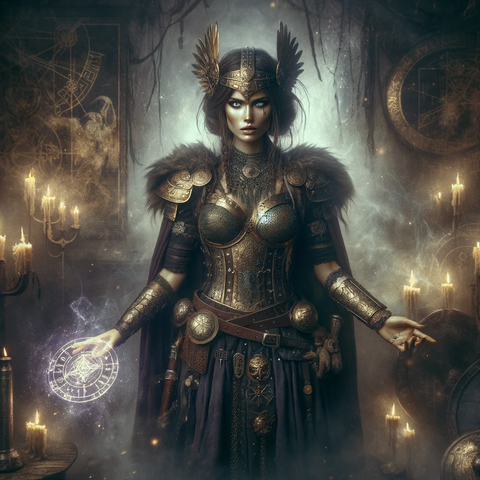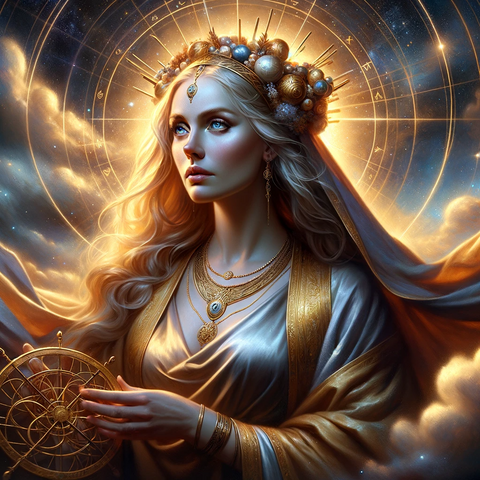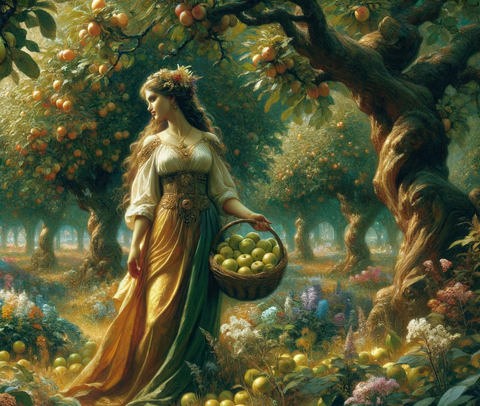🎁 It’s Black Friday Week: Get 10% off with the code BLACK10
🎁 It’s Black Friday Week: Get 10% off with the code BLACK10
Nordic Goddesses
November 04, 2023 6 min read

The Nordic Goddesses: Power and Mystery in Scandinavian Mythology
In the ancient Scandinavian sagas, where the echoes of battles resonate and tales of magic and courage come to life, the Nordic goddesses weave threads of gold through the fabric of Viking mythology. These divine figures, often overshadowed by their male counterparts like Odin and Thor, hold crucial roles in the beliefs and daily life of the Vikings. From Freya, the goddess of love and war, to Frigg, the wise matriarch of the Aesir, each goddess embodies a unique facet of life and Norse cosmology. This article dives into the fascinating world of these powerful goddesses, exploring their stories, their influences, and their indelible legacy that endures well beyond their ancient myths.
Freya - The Iconic Goddess

Within the pantheon of Nordic goddesses, Freya stands out for her versatility and power. Known as the goddess of love, fertility, sorcery, gold, war, and death, Freya is a complex and nuanced figure. Her most prized possession, the Brisingamen necklace, is a symbol of her beauty and allure, but also of her determination and cunning, as legends recount how she acquired it in exchange for favors to four dwarf smiths.
Freya is also a central figure in the Viking afterlife. She rules over Folkvangr, a resting field for half of the warriors fallen in battle, the other half being welcomed into Odin's Valhalla. This division of souls illustrates her role equivalent to that of Odin in mythology and underlines her importance in the Nordic pantheon.
Her influence extends well beyond the myths, permeating Viking culture through the ages. Names inspired by Freya are a testament to her enduring imprint, with many Viking names reflecting her attributes and power. In modern practices, she is often associated with fertility and abundance, and her spirit is celebrated in festivals and rituals that honor femininity and the earth.
Frigg - The Matriarch of the Aesir

In the starry sky of Norse mythology, Frigg stands with grace and authority. Wife of Odin and mother of the gods Balder and Hodr, she is the goddess of love, marriage, and maternity. Frigg is often confused with Freya, though their spheres of influence are distinct. Frigg is a visionary, a prophetess who can see into the future, but chooses to keep her visions to herself, a trait that highlights her contemplative nature and wisdom.
Her love and devotion for her family are at the heart of many stories. The most poignant is where she makes the rounds of all elements and entities to secure an oath not to harm her beloved son, Balder. Despite her efforts, Balder's fate is sealed by Loki's trickery, a tragedy that brings emotional depth to the figure of Frigg.
As the matriarch of the Aesir, Frigg is also tied to the concept of the home and hearth. She is the one who weaves the clouds, spinning the fate of men and gods with her heavenly spinning wheel. In Viking society, where the hearth is central, Frigg occupies a prime place, influencing norms and values around family and marriage.
Frigg's presence is palpable in Valhalla, where she resides alongside Odin, offering comfort to the souls of warriors and presiding over the eternal festivities. Her ability to maintain harmony within the celestial court, even in the face of Odin's complex relationships, attests to her diplomacy and emotional intelligence.
Idun - The Eternal Youth

At the heart of the verdant orchards of Asgard stands Idun, the keeper of the magical apples of youth. This Nordic goddess, a symbol of renewal and vitality, is essential to the survival of the gods, offering them the fruits that grant them eternity and vigor. Her role transcends mere guardianship of the apples; Idun represents the eternal spring, the promise of rebirth after the long winters.
The most famous legend of Idun is that of her abduction by the giant Thjazi, orchestrated by the mischievous Loki. Deprived of her apples, the gods begin to age rapidly, a powerful metaphor for life's dependence on the cycles of nature. The restoration of Idun to Asgard, thanks to Loki's cunning, is a victory for vitality and eternal youth.
Idun is often celebrated during Ostara, a festival that marks the spring equinox and the fertility of the earth. Her figure is a constant reminder that even after the darkest periods, life finds a way to renew and thrive.
Sif, Sigyn, and Other Female Figures

In the complex weave of Norse myths, other goddesses play equally essential roles. Sif, with her golden hair, is the goddess of fertility and the earth, wife of the mighty Thor. Her hair, cut by Loki in a cruel prank, is later replaced by golden strands made by dwarves, symbolizing the wheat fields and harvest.
Sigyn, the loyal wife of Loki, is a model of fidelity and dedication. In the darkest moments, she stays by Loki's side, collecting venom from a serpent to save him from eternal suffering. Her story is a lesson in resilience and strength in adversity.
Among the other goddesses is Hel, ruler of the realm of those who did not find glory in battle. She reigns over a vast and dark territory, welcoming those who pass into the afterlife with an impartiality that defies notions of good and evil. Hel, daughter of Loki, is often depicted as an ambivalent figure, half-alive, half-dead, reflecting the duality of life and death.
Gefion - The Plough Goddess

In the Norse divine pantheon, Gefion stands out as a symbol of foresight and prosperity. She is the goddess who, according to the myth, plowed the island of Zealand from Sweden. The tale of Gefion is a tribute to the virtues of hard work and ingenuity, turning a piece of land into a prosperous island by the strength of her will and her connection with the oxen that plowed the land, who were actually her sons transformed into powerful beasts.
The story of Gefion reminds us of the intimate relationship between the Norse gods and the land, and her legacy can be seen in the fertile fields that were so crucial to Viking agrarian life. Her connection with the soil and agriculture is celebrated in rituals that honor the earth and the abundance it provides.
Eir - The Healing Hand

In sagas where warriors clash and battles rage, there is also Eir, a goddess or, according to some accounts, a valkyrie associated with medical skill and healing. Her name, meaning "help" or "mercy," reflects her role as a divine healer, providing comfort and recovery to those in need. Eir is often invoked in the context of health and well-being, embodying the vital aspect of healing in Norse mythology.
Her presence is a comforting notion in a world where wounds and diseases were common and often fatal. Eir's expertise in healing is not only physical but also extends to the spiritual realm, offering a holistic approach to health that was ahead of its time.
Skadi - The Goddess of the Hunt and Winter

Skadi, the giantess goddess associated with bow hunting, skiing, winter, and mountains, is a figure of strength and independence. The daughter of a giant, she is known for having chosen her husband among the gods by only seeing their feet. Skadi is also associated with vengeance, having sought to punish the gods for the death of her father. Her determination and ability to survive in the harshest environments make her a respected and feared deity.
In the snowy landscapes of Scandinavia, Skadi embodies the wild spirit of nature. She reminds us of the challenges of winter and the resilience needed to overcome them. Her worship is particularly relevant in regions where winter dominates and shapes the lives of the people.
The Tapestry of the Valkyries
Beyond individual goddesses, the valkyries hold a special place in Norse mythology. These warrior maidens, serving Odin, chose those who were to die and those who were to live in battles. They are often depicted as fierce and relentless, but they also weave the threads of fate, guiding the souls of warriors to Valhalla, where they find glory in the afterlife.
The valkyries represent the complex nature of Norse mythology, where death in battle is not an end but the beginning of a new existence in the halls of the gods. Their stories are filled with bravery, tragedy, and the spectral beauty of their flight across the skies.
The Legacy of the Norse Goddesses
The legacy of the Norse goddesses transcends the ages, resonating powerfully in our contemporary era. These mythological figures, once revered in the Scandinavian fjords, continue to captivate the collective imagination through various cultural expressions, from narrative arts to renewed spiritual practices. They embody timeless principles of resilience, wisdom, and balance, reflecting the complexity of human experiences and the depth of our connection with nature.
Their enduring presence in popular culture and in the hearts of those who seek to embrace ancient traditions is a testament to the power and inspiration that these mythological figures continue to offer. In them, we find archetypes that illuminate our understanding of the past and enrich our experience of the present.
Thus, the Norse goddesses remain not only subjects of fascination but also spiritual guides and symbols of the life force that animates the world. Their narrative, far from being fixed in the runestones of the past, is alive, dynamic, and constantly evolving, inviting everyone to discover the ancient wisdom that still lights the way for humanity.
Leave a comment
Comments will be approved before showing up.




